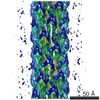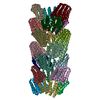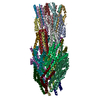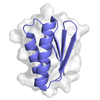+ Open data
Open data
- Basic information
Basic information
| Entry | Database: EMDB / ID: EMD-0252 | |||||||||
|---|---|---|---|---|---|---|---|---|---|---|
| Title | Cryo-EM of self-assembly peptide filament LRV_M3delta1 | |||||||||
 Map data Map data | ||||||||||
 Sample Sample |
| |||||||||
 Keywords Keywords | filament / self-assembly peptide filament / Cryo-EM / PROTEIN FIBRIL | |||||||||
| Biological species |  Azotobacter vinelandii (bacteria) Azotobacter vinelandii (bacteria) | |||||||||
| Method | helical reconstruction / cryo EM / Resolution: 4.4 Å | |||||||||
 Authors Authors | Osinski T / Wang F | |||||||||
| Funding support |  United States, 1 items United States, 1 items
| |||||||||
 Citation Citation |  Journal: Proc Natl Acad Sci U S A / Year: 2019 Journal: Proc Natl Acad Sci U S A / Year: 2019Title: Ambidextrous helical nanotubes from self-assembly of designed helical hairpin motifs. Authors: Spencer A Hughes / Fengbin Wang / Shengyuan Wang / Mark A B Kreutzberger / Tomasz Osinski / Albina Orlova / Joseph S Wall / Xiaobing Zuo / Edward H Egelman / Vincent P Conticello /  Abstract: Tandem repeat proteins exhibit native designability and represent potentially useful scaffolds for the construction of synthetic biomimetic assemblies. We have designed 2 synthetic peptides, HEAT_R1 ...Tandem repeat proteins exhibit native designability and represent potentially useful scaffolds for the construction of synthetic biomimetic assemblies. We have designed 2 synthetic peptides, HEAT_R1 and LRV_M3Δ1, based on the consensus sequences of single repeats of thermophilic HEAT (PBS_HEAT) and Leucine-Rich Variant (LRV) structural motifs, respectively. Self-assembly of the peptides afforded high-aspect ratio helical nanotubes. Cryo-electron microscopy with direct electron detection was employed to analyze the structures of the solvated filaments. The 3D reconstructions from the cryo-EM maps led to atomic models for the HEAT_R1 and LRV_M3Δ1 filaments at resolutions of 6.0 and 4.4 Å, respectively. Surprisingly, despite sequence similarity at the lateral packing interface, HEAT_R1 and LRV_M3Δ1 filaments adopt the opposite helical hand and differ significantly in helical geometry, while retaining a local conformation similar to previously characterized repeat proteins of the same class. The differences in the 2 filaments could be rationalized on the basis of differences in cohesive interactions at the lateral and axial interfaces. These structural data reinforce previous observations regarding the structural plasticity of helical protein assemblies and the need for high-resolution structural analysis. Despite these observations, the native designability of tandem repeat proteins offers the opportunity to engineer novel helical nanotubes. Moreover, the resultant nanotubes have independently addressable and chemically distinguishable interior and exterior surfaces that would facilitate applications in selective recognition, transport, and release. | |||||||||
| History |
|
- Structure visualization
Structure visualization
| Movie |
 Movie viewer Movie viewer |
|---|---|
| Structure viewer | EM map:  SurfView SurfView Molmil Molmil Jmol/JSmol Jmol/JSmol |
| Supplemental images |
- Downloads & links
Downloads & links
-EMDB archive
| Map data |  emd_0252.map.gz emd_0252.map.gz | 2.1 MB |  EMDB map data format EMDB map data format | |
|---|---|---|---|---|
| Header (meta data) |  emd-0252-v30.xml emd-0252-v30.xml emd-0252.xml emd-0252.xml | 9.3 KB 9.3 KB | Display Display |  EMDB header EMDB header |
| Images |  emd_0252.png emd_0252.png | 321.9 KB | ||
| Filedesc metadata |  emd-0252.cif.gz emd-0252.cif.gz | 4.7 KB | ||
| Archive directory |  http://ftp.pdbj.org/pub/emdb/structures/EMD-0252 http://ftp.pdbj.org/pub/emdb/structures/EMD-0252 ftp://ftp.pdbj.org/pub/emdb/structures/EMD-0252 ftp://ftp.pdbj.org/pub/emdb/structures/EMD-0252 | HTTPS FTP |
-Validation report
| Summary document |  emd_0252_validation.pdf.gz emd_0252_validation.pdf.gz | 263.6 KB | Display |  EMDB validaton report EMDB validaton report |
|---|---|---|---|---|
| Full document |  emd_0252_full_validation.pdf.gz emd_0252_full_validation.pdf.gz | 262.7 KB | Display | |
| Data in XML |  emd_0252_validation.xml.gz emd_0252_validation.xml.gz | 5.1 KB | Display | |
| Arichive directory |  https://ftp.pdbj.org/pub/emdb/validation_reports/EMD-0252 https://ftp.pdbj.org/pub/emdb/validation_reports/EMD-0252 ftp://ftp.pdbj.org/pub/emdb/validation_reports/EMD-0252 ftp://ftp.pdbj.org/pub/emdb/validation_reports/EMD-0252 | HTTPS FTP |
-Related structure data
| Related structure data |  6hqeMC  9136C  6mk1C M: atomic model generated by this map C: citing same article ( |
|---|---|
| Similar structure data |
- Links
Links
| EMDB pages |  EMDB (EBI/PDBe) / EMDB (EBI/PDBe) /  EMDataResource EMDataResource |
|---|---|
| Related items in Molecule of the Month |
- Map
Map
| File |  Download / File: emd_0252.map.gz / Format: CCP4 / Size: 8 MB / Type: IMAGE STORED AS FLOATING POINT NUMBER (4 BYTES) Download / File: emd_0252.map.gz / Format: CCP4 / Size: 8 MB / Type: IMAGE STORED AS FLOATING POINT NUMBER (4 BYTES) | ||||||||||||||||||||||||||||||||||||||||||||||||||||||||||||
|---|---|---|---|---|---|---|---|---|---|---|---|---|---|---|---|---|---|---|---|---|---|---|---|---|---|---|---|---|---|---|---|---|---|---|---|---|---|---|---|---|---|---|---|---|---|---|---|---|---|---|---|---|---|---|---|---|---|---|---|---|---|
| Projections & slices | Image control
Images are generated by Spider. | ||||||||||||||||||||||||||||||||||||||||||||||||||||||||||||
| Voxel size | X=Y=Z: 1.32 Å | ||||||||||||||||||||||||||||||||||||||||||||||||||||||||||||
| Density |
| ||||||||||||||||||||||||||||||||||||||||||||||||||||||||||||
| Symmetry | Space group: 1 | ||||||||||||||||||||||||||||||||||||||||||||||||||||||||||||
| Details | EMDB XML:
CCP4 map header:
| ||||||||||||||||||||||||||||||||||||||||||||||||||||||||||||
-Supplemental data
- Sample components
Sample components
-Entire : self-assembly peptide filament
| Entire | Name: self-assembly peptide filament |
|---|---|
| Components |
|
-Supramolecule #1: self-assembly peptide filament
| Supramolecule | Name: self-assembly peptide filament / type: complex / ID: 1 / Parent: 0 / Macromolecule list: all |
|---|---|
| Source (natural) | Organism:  Azotobacter vinelandii (bacteria) Azotobacter vinelandii (bacteria) |
-Macromolecule #1: peptide LRV_M3delta1
| Macromolecule | Name: peptide LRV_M3delta1 / type: protein_or_peptide / ID: 1 / Number of copies: 52 / Enantiomer: LEVO |
|---|---|
| Source (natural) | Organism:  Azotobacter vinelandii (bacteria) Azotobacter vinelandii (bacteria) |
| Molecular weight | Theoretical: 2.579933 KDa |
| Sequence | String: PEALERLAAD PDREVRAAVA RRL |
-Experimental details
-Structure determination
| Method | cryo EM |
|---|---|
 Processing Processing | helical reconstruction |
| Aggregation state | filament |
- Sample preparation
Sample preparation
| Buffer | pH: 6 |
|---|---|
| Vitrification | Cryogen name: ETHANE |
- Electron microscopy
Electron microscopy
| Microscope | FEI TITAN KRIOS |
|---|---|
| Image recording | Film or detector model: GATAN K2 SUMMIT (4k x 4k) / Detector mode: COUNTING / Average electron dose: 52.0 e/Å2 |
| Electron beam | Acceleration voltage: 300 kV / Electron source:  FIELD EMISSION GUN FIELD EMISSION GUN |
| Electron optics | Illumination mode: FLOOD BEAM / Imaging mode: BRIGHT FIELD |
| Experimental equipment |  Model: Titan Krios / Image courtesy: FEI Company |
- Image processing
Image processing
| Final reconstruction | Applied symmetry - Helical parameters - Δz: 1.15 Å Applied symmetry - Helical parameters - Δ&Phi: -20.7 ° Applied symmetry - Helical parameters - Axial symmetry: C1 (asymmetric) Algorithm: BACK PROJECTION / Resolution.type: BY AUTHOR / Resolution: 4.4 Å / Resolution method: OTHER / Software - Name: SPIDER / Details: Model:Map FSC 0.38 cut off, d99 and d model / Number images used: 62616 |
|---|---|
| Startup model | Type of model: OTHER / Details: featureless cylinder |
| Final angle assignment | Type: NOT APPLICABLE |
 Movie
Movie Controller
Controller











 Z (Sec.)
Z (Sec.) Y (Row.)
Y (Row.) X (Col.)
X (Col.)





















